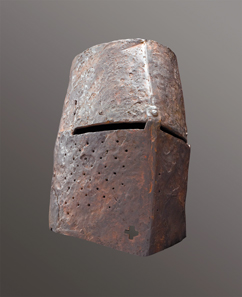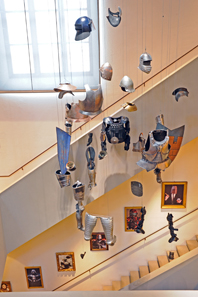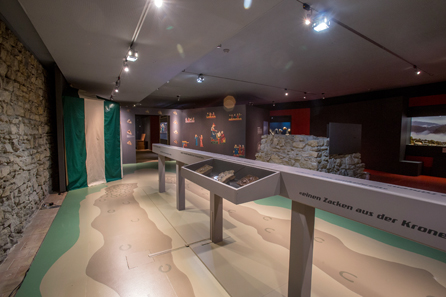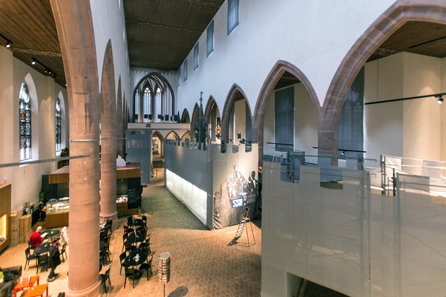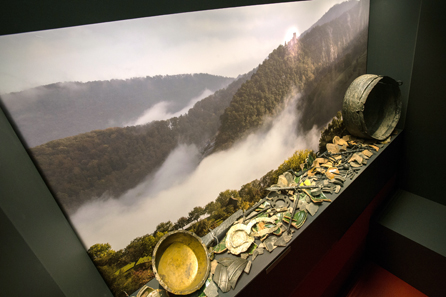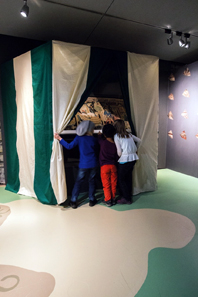December 5, 2013 – ‘Real Castles – Imaginary Knights?’ at Basel’s Museum of History / Barfüsser Church is a coproduction of Basel Historical Museum with Archäologie Baselland. The exhibition that is to run from 15 November 2013 to 29 June 2014 explores the unbroken fascination that knights and castles still hold for us today and uncovers the origins of many of our clichéd notions of chivalry.
Heaume from Madeln Castle nearby Pratteln, before 1356. The castle was the home of the Eptingers, an important family of knights from this region. Photo: HMB Peter Portner.
Drawing on the archaeological and historical evidence, the show follows a line of inquiry that differentiates between fact and fantasy, true and false. The Basel region is an ideal location for such an undertaking. The Baselbiet has more castles than almost anywhere else in the world and Basel’s knights and their tournaments were famed far beyond the city limits.
Selected castles in the region are presented through models created using the latest 3D printing processes and archaeological finds. The 18th and 19th century exhibits with their romanticized view of castles are offered as evidence of the medievalism that even today shapes how we imagine the chivalric way of life. They also prove that not even historians are above fantasizing!
View on the stairs. Photo: HMB Peter Portner.
Clichéd images of knights in shining armour rushing to the aid of damsels in distress are just part of the picture, however. Knights live on in our use of terms such as ‘chivalrous’ or ‘unchivalrous’ to describe certain types of behaviour and in heroic figures such as the Jedi knights of Star Wars fame. The idealization of knighthood actually began in the Middle Ages, when knights were elevated from simple warriors to champions of righteousness and later, during the Crusades, to soldiers of Christ. This so impressed the new class of upwardly mobile burghers that many of them began aspiring to knighthood, too, especially as certain political offices were reserved for members of the class of knights only. The exhibition turns the spotlight on three Basel burghers of the 13th-15th century, each of whom chose his own path to knighthood.
View on the exhibition. Photo: HMB Philipp Emmel.
The last section of the exhibition is devoted to the decline of the knights and the affluent burghers and civic authorities that took their place. After purchasing the knights’ castles, the City of Basel dispatched Landvögte – officials with jurisdiction and fiscal powers – to administer the vacated domains. The castles were blazoned with the Basel coat of arms, which thus became a very visible symbol of the rule of the town over the country.
Centuries later, opponents of a grassroots initiative to reunite the cantons of Basel Stadt and Baselland appealed to the lessons of history when warning of the dangers of once again ceding hegemony to the city. The feudal lords in their castles have thus remained on the political agenda to this day.
View into the nave. Photo: HMB Philipp Emmel.
The exhibition is staged in a way that makes it both informative and exciting. Erected inside the nave of the Barfüsser Church are three towers, one of which can be ascended, while the medieval exhibits in the basement are grouped around a tiltyard.
Here, knights’ helmets with integrated films of jousting knights give visitors an inkling of just how thrilling tournaments could be. There are also over 20 media stations, including an interactive castle map, as well as an opportunity to dress up as a knight by donning the armour of a Knight Hospitaller of ca. 1250.
A monthly competition on Twitter #HMBRitter will award prizes for the photo showing the most original costume.
View on the exhibition. Photo: HMB Peter Portner and Philipp Emmel.
Tours in three languages will provide an overview of the show, introduce the most important issues raised and examine selected exhibits in their larger context. The Volkshochschule beider Basel has teamed up with the HMB to offer a series of lectures.
View on the exhibition. Photo: HMB Philipp Emmel.
There is an especially wide range of tours and events for children with games and activities on four Saturday afternoons in the run up to Christmas, family tours, children’s birthday parties, Sunday family specials and even an introduction to hand to hand combat enabling children of all ages to learn all about knights and their castles through guessing games and play. HMB Junior, a booklet that allows children to discover the exhibition for themselves accompanied only by a friendly dragon, serves much the same purpose. There will also be four age specific tours for parties of schoolchildren from primary level upwards. What do knights mean to us today? Who are our knights in shining armour? And is our image of the Middle Ages simply a fiction? These are questions that are of relevance to older children, too.
Further details of the peripheral programme and all information regarding the exhibition are available on the museum’s website.





